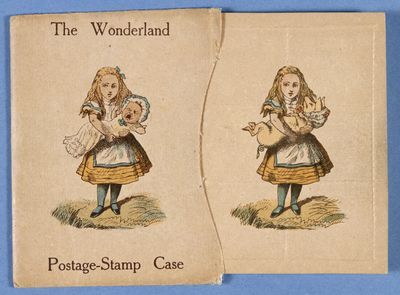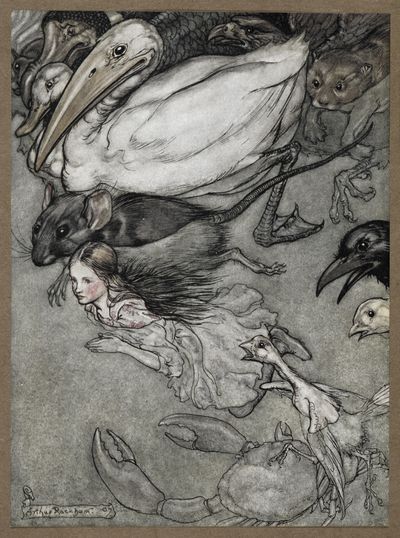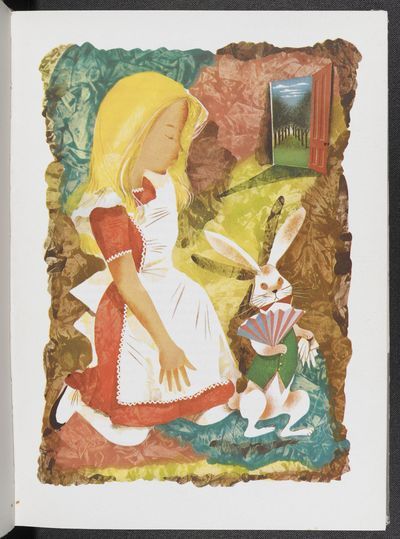Alice at the British Library
By MICHAEL CAINES
Alice in Wonderland suffered a false start. The Reverend Charles Dodgson's immortal nonsense first appeared in print 150 years ago, in the summer of 1865, only for that first edition to be withdrawn after its illustrator John Tenniel complained about the quality of the printing. The reset edition, dated 1866, was available from November 11. Dodgson ��� or Lewis Carroll to the public ��� imagined he would lose ��100 on the book, after an initial outlay of ��600. He imagined perhaps issuing the book again and breaking even ��� "but that I can hardly hope for". You probably know the rest of the story ��� although not necessarily as it's presented at the British Library from this week onwards . . . .
The BL's new free Alice in Wonderland exhibition (just a skip or struggle up the stairs from the ground floor) tours the world of Wonderland from conception (a boat trip with three daughters of the Dean of Christ Church, Oxford, and the superbly named Robinson Duckworth, a friend from Trinity College) to illustrated editions of the twenty-first century. Here is the Wonderland manuscript, illustrated by the author, and the Tenniel woodblocks (only recovered from the publisher's bank vault in 1985); but also various attempts to outdo Tenniel by Arthur Rackham (typically fey, menacingly grey):
Leonard Weisgard (note the unconventionally red dress, in contrast to the customary blue):
And Helen Oxenbury (a self-camouflaging Cheshire Cat with eyes closed, unlike Tenniel's more watchful predecessor):
These are set alongside Willy Pogany's "Flapper Alice" of 1929 (with its chorus lines of playing card courtiers), a wartime Alice in Wunderground by Michael Henry Barsley (rationed to a "Molotov Bread basket" at the Mad Hatter's tea party), Salvador Dal��'s unimpressive 1969 effort, John Vernon Lord's politically daubed version of 2009 (with Alice's words printed in pinafore-blue) and a characteristically spotted revision from Yayoi Kusama. There is also a listening post for those who wish to hear nonsensical delights such as the Wonderland Quadrille and plentiful evidence of Alice-the-brand, in the form of a jigsaw, a spinning top (aptly adorned with the White Rabbit's rushing words: "I'm late, I'm late . . .") and the postage stamp case pictured above. This last item seems especially appropriate given that line in the "Looking-glass Insects" chapter of Through the Looking-glass, in which our heroine finds herself on a train, only for a fellow passenger to suggest an alternative means of transport: "she must go by post, as she's got a head on her . . ." ��� "head" being Victorian slang for a postage stamp.
I'm grateful to the friend who also attended the press view for pointing out that the captions are not entirely to be trusted ��� friendship is a slightly misleading term for Carroll's relations with the Rossettis. And I think the point about Carroll's making the most of his success by encouraging translations of his work (a subject exhaustively explored in this recent publication from Oak Knoll Press), a "nursery" edition and so on needs qualification: by examining his bank account records, Jenny Woolf has shown in The Mystery of Lewis Carroll that he never made an outrageous fortune from Alice. There is an Alice biscuit tin, but "by modern standards, this merchandising was very modest indeed".
(Who was Carroll's inspiration for the Mad Hatter, by the way? Here's one recent identification of a real-life "Oxford eccentric", published in the TLS a couple of years ago.)
With thanks to Lindsay Duguid.
Peter Stothard's Blog
- Peter Stothard's profile
- 30 followers







